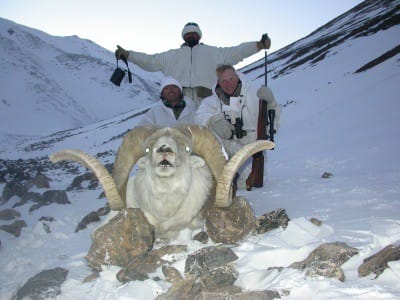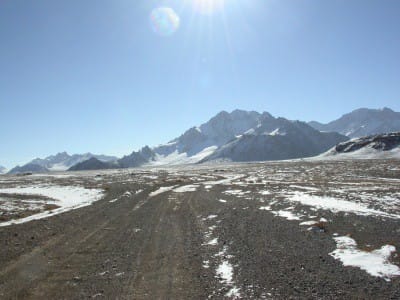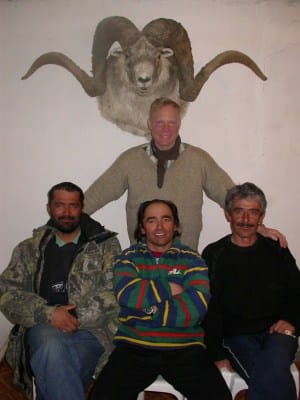 The year was probably 1272 when Venetian traveler Marco Polo first encountered the wild sheep with the fantastically curling horns that, more than 700 years later, still bears his name. This meeting almost certainly took place in the Pamir Mountains of Central Asia, a range of high valleys and rocky ridges that lead from present-day Kyrgyzstan, Tajikistan, and Afghanistan into western China. For Marco Polo, this “roof of the world” offered a potential trade route to the Orient. For today’s naturalists and sportsmen, the Pamirs, plus a small slice of northeastern Pakistan, define the range of the most coveted of the world’s wild sheep, the Marco Polo argali.
The year was probably 1272 when Venetian traveler Marco Polo first encountered the wild sheep with the fantastically curling horns that, more than 700 years later, still bears his name. This meeting almost certainly took place in the Pamir Mountains of Central Asia, a range of high valleys and rocky ridges that lead from present-day Kyrgyzstan, Tajikistan, and Afghanistan into western China. For Marco Polo, this “roof of the world” offered a potential trade route to the Orient. For today’s naturalists and sportsmen, the Pamirs, plus a small slice of northeastern Pakistan, define the range of the most coveted of the world’s wild sheep, the Marco Polo argali.
The argalis are a tall, long-legged “running” sheep, as opposed to the shorter-legged, thicker-bodied “climbing sheep” like our North American varieties. The genus and species isOvis ammon, with O. a. poli just one of numerous races and subspecies, some of which are still in dispute. Not in dispute is that, surprisingly, the Marco Polo is not the largest argali in either body or horn mass. This honor goes to the type specimen, Ovis ammon ammon, the tall, heavy-horned wild sheep of Mongolia’s Altai Mountains (thus his common name, the Altai argali).
What Marco Polo’s sheep offers instead is the longest horns of all the wild sheep, with a very few specimens exceeding six feet (72 inches!) around the curl of each horn. These on an animal that lives in very high, remote country, and presents an incredibly regal appearance and bearing. Like most big animals around the world he is not as big as often described, but he is a big, tall sheep, with mature rams standing about 44 inches at the shoulder and weighing just a bit shy of 300 pounds. This argali wears a russet saddle, with white underparts and neck and a prominent white rump patch, and he lacks the neck ruff or bib prominent in most races of argali.
For centuries he persisted almost as a rumor, virtually unknown to the outside world. In the late 19th and early 20th Centuries a few hardy sportsmen hunted him in western China and the frontier of northern India (now Pakistan)-but until the breakup of the Soviet Union most of the Marco Polo argali’s range was solidly locked behind the Iron Curtain, forbidden to western sportsmen. The only real exception was the remote Wakhan Corridor of northern Afghanistan. Pioneered by the Klineburger brothers, this area was available to sport hunters from 1968 until the Russian invasion in late 1979.
To this day my friends who hunted the Marco Polo sheep in Afghanistan view the modern hunting in Tajikistan and Kyrgyzstan with a jaundiced eye! The Wakhan Corridor was several days of rough travel from Kabul. It was high and steep and difficult, much of the border unmarked with Chinese patrols to the east, Russians to the north. It was also the extreme southern limit of the Marco Polo range. There weren’t many sheep, rarely were they huge (Note: By North American standards, “small” Marco Polo sheep are huge!), and the logistically almost impossible hunt was extremely expensive. Even so, it was a chance-the only chance-to hunt the legendary Marco Polo ram.

The breakup of the Soviet Union created our modern opportunity to hunt Marco Polo’s argali. It is, admittedly, not as adventurous as the Wakhan Corridor. But it is also not nearly as expensive, and today we are able to hunt the heart of the Marco Polo’s range. Afghanistan is currently closed for obvious reasons. Western China has been open, is closed right now, and in any case Americans have not been allowed to import argali trophies from China. The two current opportunities are Kyrgyzstan and Tajikistan-and I rate them together as the best sheep hunts in the entire world.
Kyrgyzstan is generally rockier, with most hunts conducted on horseback. The sheep generally average a bit smaller, and today most sheep hunting nuts consider the Kyrgyzstan sheep as “Hume argali,” a similar subspecies differentiated by slightly smaller size and a more pronounced bib. The Kyrgyzstan hunts are a bit less expensive, probably reflecting the somewhat smaller trophies.
My own experience has been in southeastern Tajikistan, with Afghanistan to the south and China to the east. It is high and rough, and not many people go back for seconds. I liked it enough that I’ve gone twice, and may well go back. The Tajik tribesmen are interesting, tough people, and the broad alluvial valleys of the Pamirs are gorgeous. The hunt is not inexpensive, but it has gone up very little since the region first opened in the early 1990s. That means that a Marco Polo argali hunt is now less than a Stone sheep hunt. If you’re rich cost doesn’t matter. If you’re poor and it’s out of reach, I suppose that doesn’t matter, either.
A better question is: Is it worth the cost? Unlike a lot of hunts in the world, the Marco Polo hunt truly is. It’s a great adventure into a wild part of the world. No trophy on Earth is more magnificent. And here’s the really cool thing: On a good day in Tajikistan’s Pamirs you may see 500 sheep. On a great day, possibly a thousand. On a slow day, surely a couple hundred.

Match that against any other sheep hunt anywhere in the world!
Seeing and shooting are not the same. The bands of Marco Polo sheep come down out of the rocks in the late afternoon to graze on sparse, snow-covered grass in the high valleys. They will feed and rest through the night, and in the morning you can glass them at great distance, like bands of moving caribou as they start to move back up into the rocks. You put them to bed, and you have the day to stalk them. The Marco Polo argali is not only one of the world’s great game animals; he offers one of the world’s greatest hunts.







